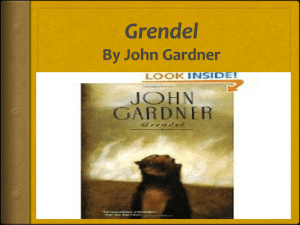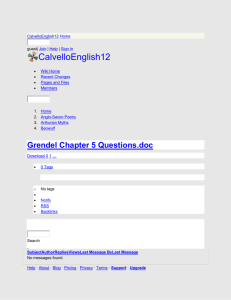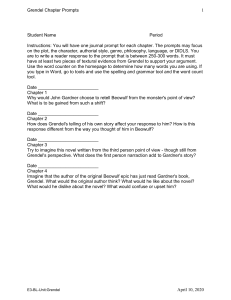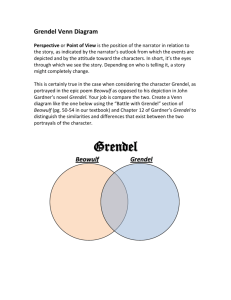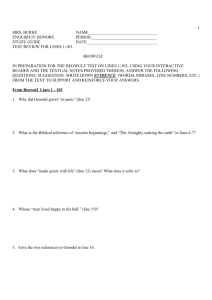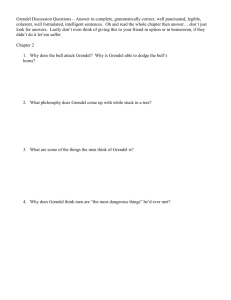Beowulf Lecture 1
advertisement
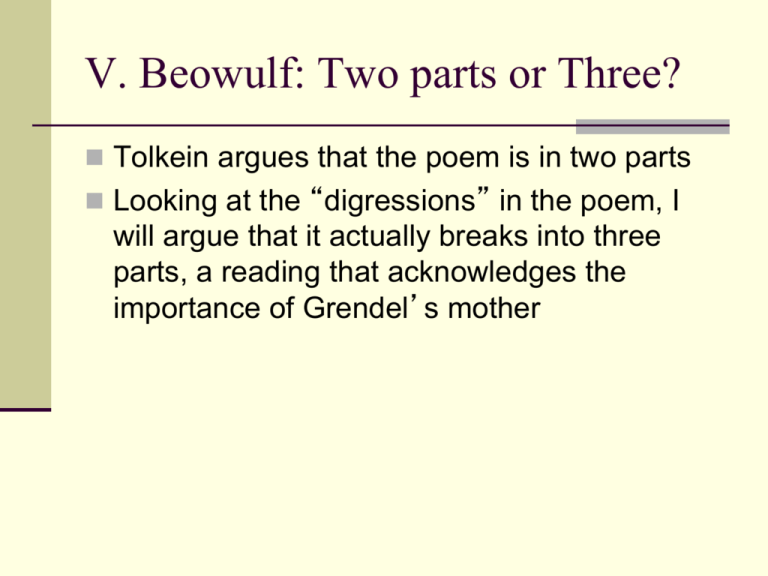
V. Beowulf: Two parts or Three? Tolkein argues that the poem is in two parts Looking at the “digressions” in the poem, I will argue that it actually breaks into three parts, a reading that acknowledges the importance of Grendel’s mother VI. “Digressions” A. The Opening B. Foreshadowings C. Flashbacks/insertions VI. Digressions A. Opening passage (lines 1-11) 1. 2. 3. 4. Genealogy Circular structure Representing a “good king” Ironic Foreshadowing VI. Digressions B. More Foreshadowing— Future Destruction of Heorot Lines 20, 81, 1016 VI. Digressions C. The Fight at Finnsburg/Lay of Finn (1062) 1. Sung to Hrothgar’s court after Grendel’s defeat 2. Story of failed alliance by marriage 3. Linked to situation of Queen Wealtheow/Grendel’s mother VII. Gender in Beowulf A. Connected figures in Wealtheow/Grendel’s Mother B. Refutation of Tolkein thesis C. Status of women in Anglo-Saxon culture D. The monstrous feminine Gender in BW Connected figures in Wealtheow/Grendel’s Mother Wealtheow’s speech, line 1167 ff. and esp. 1214 ff. Grendel’s mother attacks—1250 ff. Both defined as mothers and connected passionately to their sons VII. Grendel’s Mother Tolkein’s thesis doesn’t recognize importance of Grendel’s mother Grendel’s mother is at the center of the poem (Niles) Her part takes up 13% (400 lines)—almost as much as Grendel Women in Anglo-Saxon society Women in Anglo-Saxon society were limited in their roles, but not powerless Scandinavian saga Carol Clover: the importance of power vs. gender in societal hierarchies Grendel’s Mother as monster The concept of abjection (Kristeva) “that which is expelled from a society in order to define cultural borders” (Trilling 3) Abjection and the maternal (Lacanian Psychoanalysis) Abjection—me and not me Grendel’s Mother She represents horror at maternal power (and women who crosses boundaries (female power, the human/not-human) But unlike Grendel, Grendel’s mother’s actions are very understandable within feud culture and her emotional ties to her son make her like the Danes (Trilling) Grendel’s Mother Represents a fundamental threat to the society Notable that Beowulf arms so thoroughly to meet her, dispatches her so immediately and doesn’t not bring her head back as a trophy Is she a greater threat than her son? Why? The heroic in Beowulf A. Defining good king in opening lines B. Hrothgar’s parting speech to Beowulf (l.1699 ff.) C. Heremod as counter-example (l. 1708) D. Beowulf’s decision to fight dragon alone— Is it heroic? Line 2529 ff Chaucer Challenge Optional contest – extra credit toward course participation grade Write your own General Prologue—set at UCSD E-Submit to Prof. Lampert-Weissig by 5 pm Oct. 14 (llampert@ucsd.edu) Subject heading: Chaucer challenge Thinksheet Week 2 Due at the beginning of your section Double-spaced, typed. ½ to one full page. No more than one page. Read through each of the following portraits carefully: The Monk (lines 165-207) The Friar (lines 209-271) The Clerk (lines 287-310) The Parson (lines 480-530) Pick ONE of these portraits and respond to the following about it: 1. Make a list of 3-5 important details in the pilgrim’s portrait. 2. What kind of details are these? Ironic? Serious? What is their effect? How do they work to create this effect? 3. How would you characterize the point of view of the narrator? Chaucer—social chameleon Died. 1400. Wrote in Middle English A poet with a good day job Master of irony “Father of English Poetry” Chaucer reading The Canterbury Tales Frame Tale—The General Prologue Pilgrimage First 18 lines Spring fever Virtuoso poetry Canterbury Cathedral The Canterbury Tales Frame Tale—The General Prologue Pilgrimage First 18 lines Spring fever Virtuoso poetry Frame Tale Perspective and Point of View The Host’s Proposal
